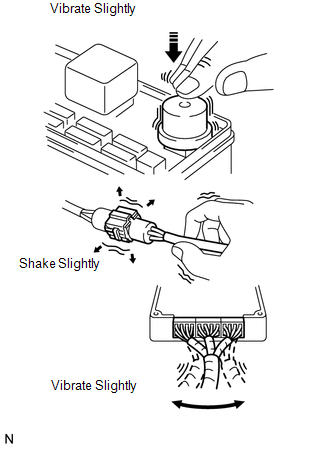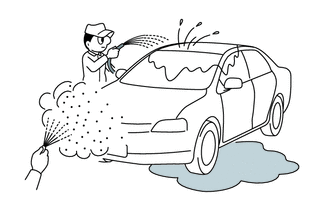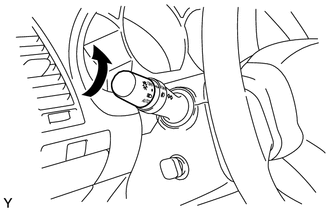HOW TO PROCEED WITH TROUBLESHOOTING 1. OPERATION FLOW HINT: Perform troubleshooting in accordance with the procedures below. The following is an outline of basic troubleshooting procedures. Confirm the troubleshooting procedures for the circuit you are working on before beginning troubleshooting. 2. 1.VEHICLE BROUGHT TO WORKSHOP 3. 2.CUSTOMER PROBLEM ANALYSIS (a) Ask the customer about the conditions and environment when the problem occurred. 4. 3.INSPECT BATTERY VOLTAGE Standard voltage: 11 to 14 V If the voltage is below 11 V, recharge or replace the battery before proceeding. 5. 4.SYMPTOM CONFIRMATION AND DTC (INCLUDING FREEZE FRAME DATA) CHECK (a) Visually check the wire harnesses, connectors and fuses for open and short circuits. (b) Warm up the engine to the normal operating temperature. (c) Confirm the problem symptoms and conditions, and check for DTCs. Result
6. 5.DTC CHART (a) Check the results obtained in the DTC check. Then find the output DTC in the DTC chart. Look at the "Trouble Area" column for a list of potentially malfunctioning circuits and / or parts. 7. 6.PROBLEM SYMPTOMS TABLE (a) Check the results obtained in the symptom confirmation. Then find the problem symptoms in the problem symptoms table. Look at the "Suspected Area" column for a list of potentially malfunctioning circuits and / or parts. 8. 7.CIRCUIT INSPECTION OR PARTS INSPECTION (a) Confirm the malfunctioning circuit or part. 9. 8.ADJUST, REPAIR OR REPLACE (a) Adjust, repair or replace the malfunctioning circuit or parts. 10. 9.CONFIRMATION TEST (a) After the adjustment, repairs or replacement, confirm that the malfunction no longer exists. If the malfunction does not reoccur, perform a confirmation test under the same conditions and in the same environment as when the malfunction occurred the first time. (b) END 11. CUSTOMER PROBLEM ANALYSIS HINT:
12. SYMPTOM CONFIRMATION AND DIAGNOSTIC TROUBLE CODE HINT: The diagnostic system in the TOYOTA TUNDRA has various functions.
13. 1.DTC CHECK 14. 2.MAKE A NOTE OF DTCS DISPLAYED AND THEN CLEAR MEMORY 15. 3.SYMPTOM CONFIRMATION Result
16. 4.SIMULATION TEST USING SYMPTOM SIMULATION METHODS 17. 5.DTC CHECK Result
18. 6.SYMPTOM CONFIRMATION Result
If a DTC was displayed in the initial DTC check, the problem may have occurred in a wire harness or connector in that circuit in the past. Check the wire harness and connectors. The problem is still occurring in a place other than the diagnostic circuit (the DTC displayed first is either for a past problem or a secondary problem). 19. SYMPTOM SIMULATION HINT: The most difficult case in troubleshooting is when no problem symptoms occur. In such a case, a thorough problem analysis must be carried out. A simulation of the same or similar conditions and environment in which the problem occurred in the customer's vehicle should be carried out. No matter how much skill or experience a technician has, troubleshooting without confirming the problem symptoms will lead to important repairs being overlooked and mistakes or delays. For example: With a problem that only occurs when the engine is cold or as a result of vibration caused by the road during driving, the problem can never be determined if the symptoms are being checked on a stationary vehicle or on a vehicle with a warmed-up engine. Vibration, heat or water penetration (moisture) is difficult to reproduce. The symptom simulation tests below are effective substitutes for the conditions and can be applied on a stationary vehicle. Important points in the symptom simulation test: In the symptom simulation test, the problem symptoms as well as the problem area or parts must be confirmed. First, narrow down the possible problem circuits according to the symptoms. Then, connect the tester and carry out the symptom simulation test, judging whether the circuit being tested is defective or normal. Also, confirm the problem symptoms at the same time. Refer to the problem symptoms table for each system to narrow down the possible causes. To reproduce DTCs, it is necessary to satisfy the respective DTC detection conditions. (a) VIBRATION METHOD: When a malfunction seems to occur as a result of vibration.  (1) PART AND SENSOR Apply slight vibration with a finger to the part of the sensor suspected to be the cause of the problem, and check whether or not the malfunction occurs. NOTICE: Applying strong vibration to relays may open them. (2) CONNECTORS Slightly shake the connector vertically and horizontally. (3) WIRE HARNESS Slightly shake the wire harness vertically and horizontally. HINT: The connector joint and fulcrum of the vibration are the major areas that should be checked thoroughly. (b) HEAT METHOD: When a malfunction seems to occur when the area in question is heated. (1) Heat the component that is the possible cause of the malfunction with a hair dryer or similar device. Check if the malfunction occurs. NOTICE:
(c) WATER SPRINKLING METHOD: When a malfunction seems to occur on a rainy day or in high-humidity.  (1) Sprinkle water onto the vehicle and check if the malfunction occurs. NOTICE:
HINT: If the vehicle has or had a water leakage problem, the leakage may have damaged the ECU or connections. Look for evidence of corrosion or short circuits. Proceed with caution during water tests. (d) HIGH ELECTRICAL LOAD METHOD: When a malfunction seems to occur when the electrical load is excessive.  (1) Turn on the heater blower, headlights, rear window defogger and all other electrical loads. Check if the malfunction reoccurs. 20. DIAGNOSTIC TROUBLE CODE CHART Look for output Diagnostic Trouble Codes (DTCs) (from the DTC checks) in the appropriate section's Diagnostic Trouble Code Chart. Use the chart to determine the trouble area and the proper inspection procedure. A description of each of the chart's columns is below.
21. PROBLEM SYMPTOMS TABLE When a "Normal" code is output during a DTC check but the problem is still occurring, use the Problem Symptoms Table. The suspected areas (circuits or parts) for each problem symptom are in the table. The suspected areas are listed in order of probability. A description of each of the chart's columns is below. HINT: In some cases, the problem is not detected by the diagnostic system even though a problem symptom is present. It is possible that the problem is occurring outside the detection range of the diagnostic system, or that the problem is occurring in a completely different system.
22. CIRCUIT INSPECTION A description of the main areas of each circuit inspection is below.
|
Toyota Tundra Service Manual > Power Steering System(for 3ur-fe, 3ur-fbe): Precaution
PRECAUTION 1. HANDLING PRECAUTIONS FOR STEERING SYSTEM (a) The vehicle is equipped with an SRS (Supplemental Restraint System) such as airbags. Failure to carry out service operations in the correct sequence could cause the SRS to unexpectedly deploy during servicing. This may cause a serious accide ...